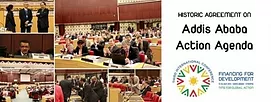
Against the odds, the global community agreed on an ‘action agenda’ for financing development. But is it up to the challenges ahead?
ADDIS ABABA — Defying widespread scepticism and mounting concern, government negotiators at a summit here have agreed to a sweeping framework aimed at financing the coming decade and a half of global development.
The Addis Ababa Action Agenda is quite similar to the most recent negotiating text for the Financing for Development process, a document that had reportedly stymied negotiators up to the very end. The agreement stops short of being a binding accord, but nonetheless is being greeted by world powers as a major achievement that allows the international community to move forward on finalizing the new Post-2015 Development Agenda.
That watershed new development strategy runs from September’s finalization of the Sustainable Development Goals through next year’s Habitat III conference on urbanization. Still, there is concern among civil society and some local authorities that the Addis agreement is not ambitious enough to be able to adequately and equitably pay for the new development agenda or to finance current need.
“Local and regional [authorities] welcome the great attention that the Addis Ababa Action Agenda puts on the need to drastically improve on domestic resource mobilization,”
Jacqueline Moustache-Belle, the mayor of Victoria, in the Seychelles, said after the agenda was finalized.
Yet she also warned that “Local and regional governments are concerned about the weak attention paid to urbanization” during the Addis conference.
“We need to double or triple urban investments over the next 15 to 20 years to avoid continuing the trend of a world which is already home to one billion slum dwellers with limited or no access to basic services,” she said, speaking on behalf of the Global Taskforce of Local and Regional Governments, an umbrella group.
“Hence our plea that urban investments financing be given a more prominent place in the development agenda at national and international levels in order to avoid the future costs of chaotic urbanization.”
A new Global Infrastructure Forum was also launched at Addis, and the Moustache-Belle urged the new initiative to “adopt an approach adapted to the needs of urban areas for developing countries. She noted that local leaders “are ready to play our role in this initiative.”
+The summit attracted more than 50 mayors, including from Harare, Johannesburg and Rabat, in the order to push for municipal financing to get a higher priority.
Private sector focus
The new action agenda has cemented a strengthened priority on public-private partnerships, a strategy that will now likely characterize the entirety of the Post-2015 Development Agenda. This is especially so around infrastructure, a major looming development requirement in poor countries around the world.
Marco Kamiya, an urban economist at UN-Habitat, says the agreement is the result of general consensus on the importance of finance for local and national infrastructure.
“The agreement states that finance should come from several areas,” he said, “not only focusing on tax reform and collection but also on ‘blended’ finances and endogenous sources of finance such as land-value sharing linked to land registration … and property taxes.”
UN-Habitat is the lead agency for next year’s Habitat III conference, which is expected to develop a new 20-year global strategy on urbanization. Kamiya says that, for his agency, the issue of financing will be central to the accord’s success, supporting urban expansion plans and design.
“Public and local finances must be sustainable and key, while overseas development assistance” — meaning foreign aid — “must be complementary,” he said. Private-sector participation, meanwhile, will be a major new component for the “blended” financing of public projects, he said.
Kamiya says that while the Addis agenda is important as a global agreement, it also has a critical local component, with a new focus being placed on raising domestic revenues. While the accord does indeed place domestic resource mobilization as a central agenda, it also notes that revenues can be expanded only by streamlining tax collection and fighting tax-dodgers and illicit financial flows.
Given this new focus, the challenge will be in building the technical capacity of local governments to allow for lower-level authorities both to negotiate with the private sector and to coordinate with central governments. According to a World Bank estimate from 2013, just 4 percent of the 500 large cities in low-income countries have access to international markets. Further, the bank warns that local governments often lack adequate credit and thus can be exposed to crippling exchange-rate risks.
Kamiya says specific capacity-building plans will thus need to be built into the SDGs and aligned in the New Urban Agenda, the intended outcome document for Habitat III.
In her comments, Victoria Mayor Moustache-Belle welcomed the “great attention” the Addis agreement puts on the need to “drastically” strengthen domestic resource mobilization. But she also warned that the new expectation of the private sector’s role in financing development is inconsistent with previous experience.
“Over the past decades, private investments in services and infrastructure were concentrated in emergent countries and in a limited number of sectors … telecommunications, transportation, and, to a lesser extent, water,”
the mayor, who is also and co-president of United Cities and Local Governments (UCLG), a global network, said.
“We hope that the Addis Ababa Action Agenda will contribute to set new policies and regulatory frameworks to set the right incentives to strengthen public and private investments in basic services and infrastructures in developing countries.”
Rising voices
While the Addis Ababa Action Agenda does include significant new monetary pledges, some are expressing concern that these aren’t nearly strong enough for the breadth of the Post-2015 Development Agenda. A broad network of civil society groups, offering their “deepest concerns”, has warned that the agreement “does not rise to world’s current multiple challenges, nor does it contain the necessary leadership, ambition and practical actions.”
Other cautions on the accord’s impact have come from within the U. N. system. Amina J. Mohammed, the United Nations’ special adviser on post-2015 development planning, lauded the new agreement but noted that money alone won’t be enough to effect the changes needed.
She said the conference addressed the issue of unfinished goals of the Millennium Development Goals — the expiring framework the SDGs will now replace — for some countries. As such, she said, the success of both the MDGs and the SDGs now rests on, among other things, scaling up support for cities, where most of the development goals will see their success or failure. The SDGs will now include, for the first time, a specific goal on urbanization.
The accord “shows that the door for sustainable development is open for all,” Mohammed said. While the basic priorities of the MDGs when it came to cities were met, she continued, it remains disappointing that the world has seen more rather than fewer slums — a pattern that will clearly need to be dealt with head on in years to come.
Cities will now be essential in order to come up with innovative new ways to deliver services, Mohammed said. But first, she warned, questions of legal sovereignty will need to be dealt with in many countries. Indeed, with Habitat III coming next year, she said she is looking forward to hearing the voices of mayors rise on such issues and bring them to the centre of the development agenda.
Source: Citiscope
See the rest of Citiscope’s Financing for Development coverage here.
